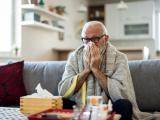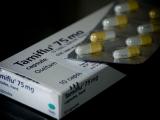Apr 13, 2005 (CIDRAP News) – The revelation that samples of the influenza virus that caused the flu pandemic of 1957-58 were inadvertently sent to thousands of laboratories has raised fears of a new pandemic and triggered an urgent effort to destroy the samples.
Samples of the influenza A(H2N2) virus were sent to 3,747 labs, the vast majority of them in the United States, the World Health Organization (WHO) said in a statement last night. The WHO recommended that all the samples, which were sent for use in lab proficiency testing, be destroyed immediately.
The H2N2 virus triggered the "Asian flu" pandemic of 1957-58, which killed an estimated 1 million to 4 million people worldwide, including 70,000 in the United States. The virus continued to circulate and cause annual epidemics until 1968, when the H3N2 virus emerged and sparked a new pandemic, the WHO said. Because the H2N2 virus has not circulated since then and is not used in current vaccines, "persons born after 1968 are expected to have no or only limited immunity to H2N2," the WHO said.
"The risk is relatively low that a lab worker will get sick, but a large number of labs got it and if someone does get infected, the risk of illness is high and this virus has shown to be fully transmissible," said Klaus Stohr, chief of the WHO's global influenza program, as reported by the Associated Press (AP). He called the sending of the samples "unwise" and "unfortunate."
The virus samples were sent to labs by the College of American Pathologists (CAP), the WHO reported. Labs use such samples to test their ability to identify viruses. The CAP paid a private company, Meridian Bioscience Inc. of Cincinnati, to prepare and send the samples, according to an AP report.
The WHO said samples of the H2N2 virus were sent to 3,747 labs in 18 countries, but only 61 of those were outside the United States and Canada. The AP report said 14 Canadian labs received the samples.
Another 2,750 labs in the United States also received samples of the virus as part of other certification processes and were asked to destroy them, according to a Washington Post report based on information from the Centers for Disease Control and Prevention (CDC).
The WHO said US health officials reported that three other organizations besides the CAP sent test kits containing the H2N2 virus to labs in the United States. In the AP report, Schwartz listed those as Medical Lab Evaluators, the American Association of Bioanalysts, and the American Association of Family Practitioners.
Neither the CAP nor Meridian Bioscience knew that the virus samples sent to labs included H2N2, according to a Washington Post report that quoted CAP spokesman Jared Schwartz. The CAP asked Meridian to send an influenza A virus, and the company's paperwork indicated that the strain was benign, Schwartz told the paper. He said he didn't know why the labeling was wrong.
The problem first came to light when workers at Canada's National Microbiology Laboratory in Winnipeg identified the virus on Mar 25 or 26, according to news services. The Public Health Agency of Canada investigated and determined that the virus came from test kits the lab had received from the CAP in February, according to the WHO.
The CAP started sending samples of the virus in October 2004, the agency said. Normally the test kits contain currently circulating influenza A viruses such as H3N2 or H1N1, officials said.
After a request by the US government, the CAP on Apr 8 asked all the labs that participate in proficiency testing to destroy samples containing the H2N2 virus, according to the WHO. Yesterday the CAP asked the labs to confirm the destruction of the samples and investigate any respiratory illness among staff members and report those cases to national authorities, the agency said.
The WHO statement added, "As of today, there have been no reports of H2N2 infections in laboratory workers associated with the distribution of the H2N2 samples from CAP. The proper use of biological safety cabinets, along with the use of recommended personal protective equipment, greatly reduces the risk of laboratory-acquired influenza infections.
"While a few H2N2 laboratory-acquired infections have been documented in the past, the likelihood of laboratory-acquired influenza infection is considered low when proper biosafety precautions are followed. The risk for the general population is also considered low."
The WHO called for a review of biosafety procedures for use on influenza viruses that have not circulated recently and to which most people lack immunity.
Besides the United States and Canada, the WHO said countries and regions with labs that received the virus samples include Bermuda, Belgium, Brazil, Chile, France, Germany, Hong Kong, Israel, Italy, Japan, Lebanon, Mexico, South Korea, Saudi Arabia, Singapore, and Taiwan.



















